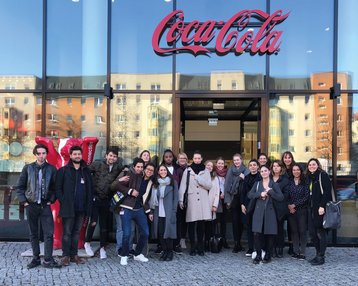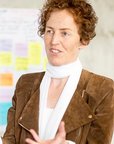Students support Coca-Cola and its customers on its journey to sustainability.

The M.A. Strategic Design and M.A Marketingkommunikation students were challenged to find new strategies how customers can be involved and take action in the recycling of Coca-Cola’s packaging.
The Social Innovation Journey
The students started the journey with the next question: How might we help the Coca-Cola brand to build a better future by motivating society to recycle its products in a sustainable way in the German market? To tackle this challenge, the students created a system mapping in order to know all the stakeholders involved and then they started the research phase involving two different approaches. The first one was based on the plastic circular economy, including packaging, distribution and recycling channels. The second approach was settled from the perspective of consumers and experts in relation to the global plastic pollution problematic.
As part of the desk research, some trends, statistics and the competitor analysis were relevant to have a clear view of the market, the audience, and new approaches that similar brands are implementing in terms of sustainability. After the research phase some synthesis was crucial to set possible opportunities. To offer a clear understanding of the outcomes, the students selected one of the projects and explained it. This group focused on three main insights that guided them to a final solution.
The first insight they found was “the Pfand system, a fairy tale” in which people believe they are behaving in a sustainable manner by using the deposit system but in reality it is not really
making an impact. The second one, called “Moral dissonance”, talks about how the issue doesn’t seem to be part of people’s lives. And the third, “Lone warriors”, where conscious consumers want to make a change but they feel alone and powerless due to a lack of support. Taking the last insight as a starting point, these lone warriors were the main focus, approaching them as local amabassadors to follow. The next question was settled to narrow the challenge: How might we help conscious consumers to feel part of a global effort, while having a real impact on
plastic pollution?
The Outcomes
Based on the insights the group created “The Plastic Pollution World Map”. It is a digital platform that involves individuals and encourages them to locate plastic, take action and make contributions that keep the map updated. But how does it work? Four basic principles are part of the sustainable cycle:
- LOCATE areas with plastic pollution in collaboration with partners that have global data on this topic.
- CONNECT with individuals to learn, take action and make a statement together.
- REVITALISE, catalyse and facilitate local recovery events tackling local problems on a global scale. Sharing achievements on the brand’s social media channels.
- UPDATE the map digitally and physically, renovating the environment.
The scope in the long term is that Coca-Cola will act as a pioneer of revitalisation of polluted areas all around the world, influencing the market and connecting people digitally as well as physically to visualise, impact and live in a world without waste.
Students of the programmes M.A. Strategic Design and M.A. Marketingkommunikation
The Challenge
One of Coca-Cola’s goals for 2025 is to keep all packaging sold in the recycling loop after consumption. The main reason for this goal is that the company wants to be part of a circular economy in which 100% of the packaging can be recyclable, reusable or refillable. Coca-Cola also wants to end the production of waste and also wants to prevent their packaging from ending up in the oceans.

